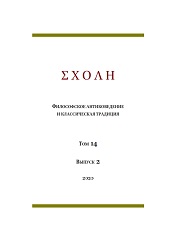The Feminine, the Origin of Evil and the Motion of Matter in Plutarch’s De animae procreatione
The Feminine, the Origin of Evil and the Motion of Matter in Plutarch’s De animae procreatione
Author(s): Lunette WarrenSubject(s): Gender Studies, Metaphysics, Ancient Philosphy, Existentialism
Published by: Новосибирский государственный университет
Keywords: Plutarch; Plato; matter; Receptacle; motion; evil; Indefinite Dyad; Isis;
Summary/Abstract: Plutarch’s De animae procreatione is, by the author’s own admission, an unusual account of the cosmogony in the Timaeus, yet what is most original about it is often overlooked. The philosopher and biographer has a relatively positive view of women’s intellectual capabilities, including their ability to attain virtue, and as such the suggestion that the feminine principle of the cosmos is the origin of sublunary evil presents both an ethical and a metaphysical problem. Plutarch attempts to solve this problem by separating Matter from its movement, thus theorising a third kind, disorderly motion that ultimately causes evil. Even so, he maintains a close relationship between Motion and Matter by stressing their acosmic interaction, which allows for a degree of scepticism regarding the feminine and the female while creating space for the virtue of women. He does so by incorporating Matter and Motion into a single acosmic principle of disorder, the Indefinite Dyad. This division of kinds is apparent also in De Iside, where it becomes clear that Plutarch intends to frame the feminine as a potentially positive force in the cosmos.
Journal: ΣΧΟΛΗ. Философское антиковедение и классическая традиция
- Issue Year: XIV/2020
- Issue No: 2
- Page Range: 374-393
- Page Count: 20
- Language: English

